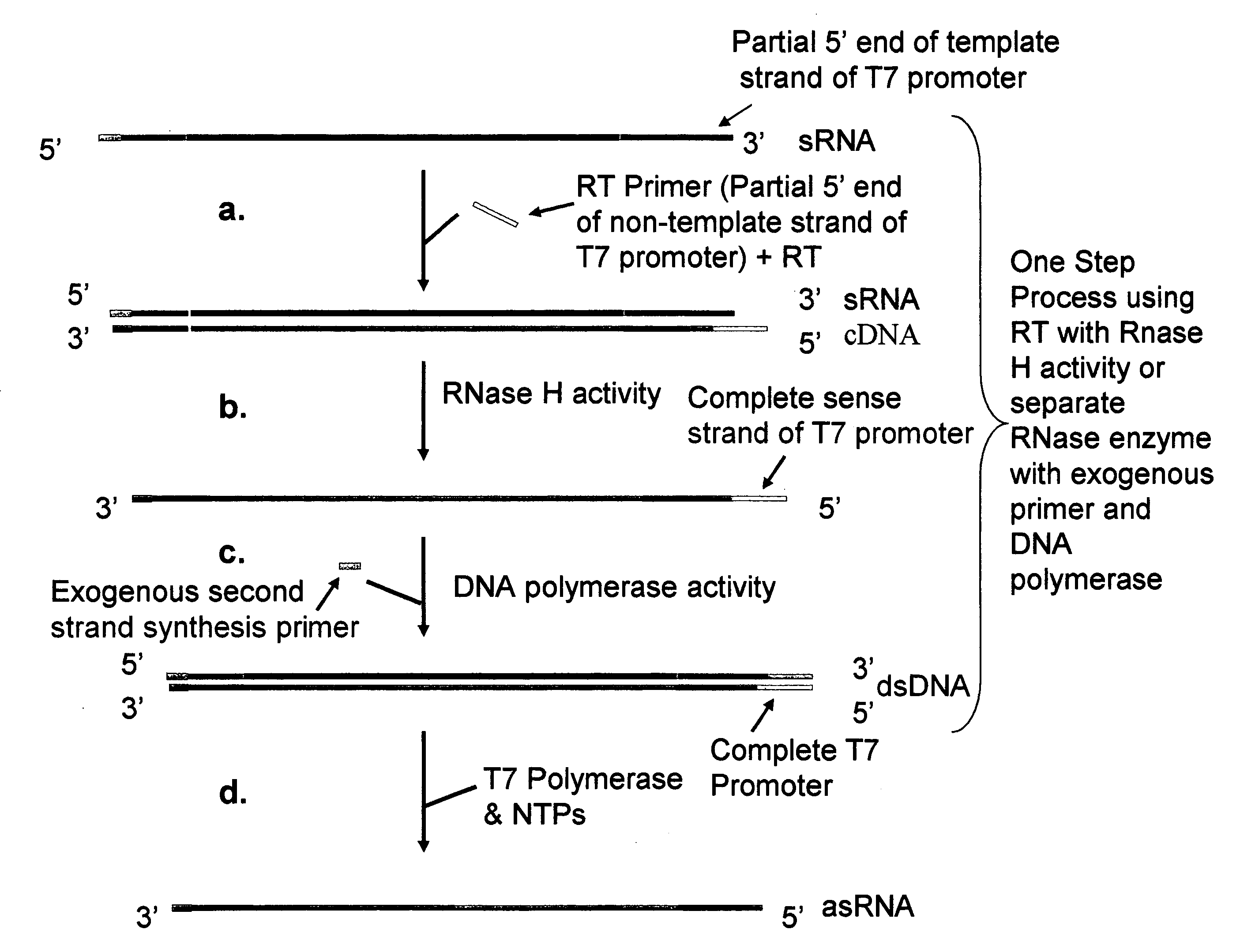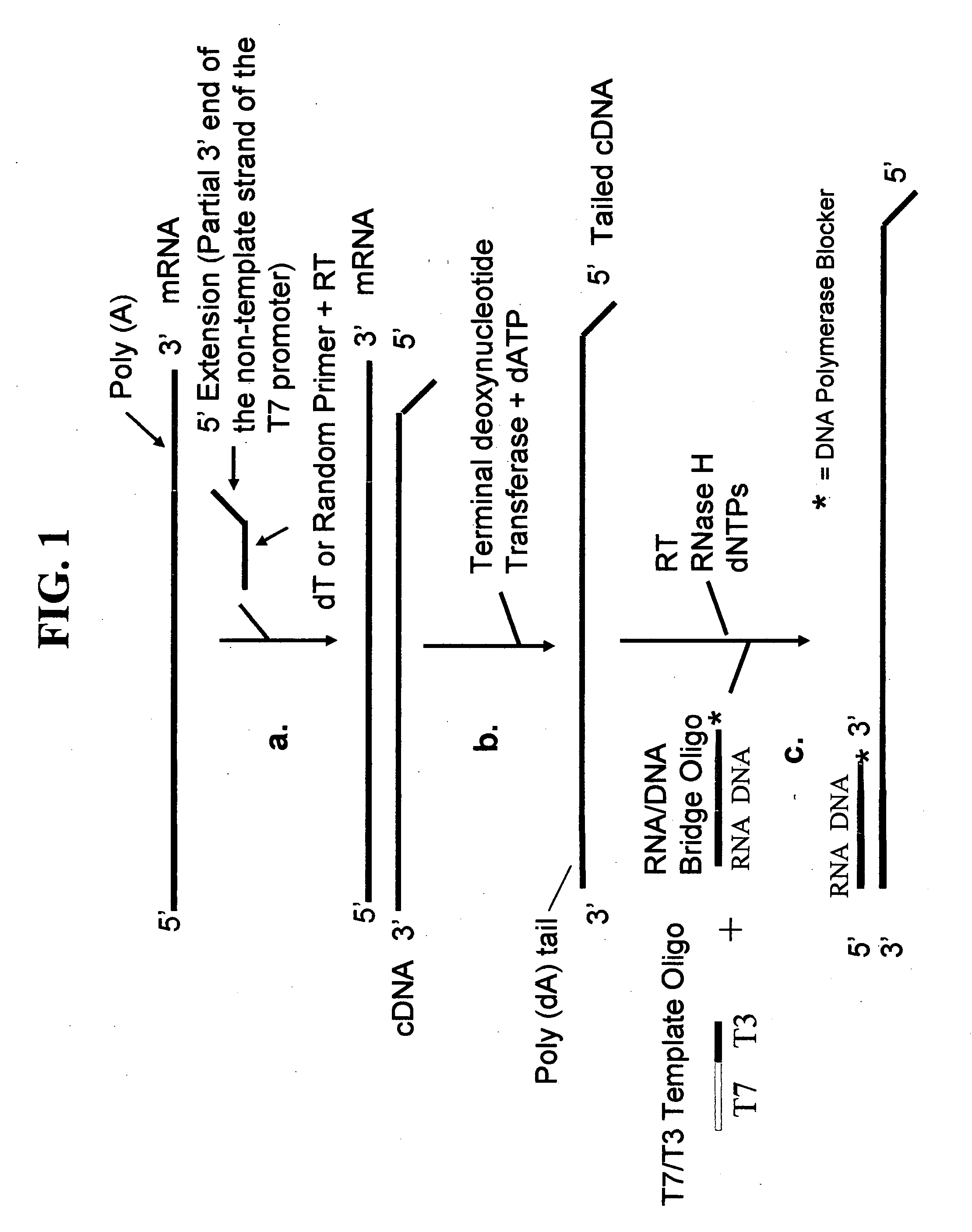Methods and kits for nucleic acid amplification
a technology of nucleic acid and amplification kit, which is applied in the field of compositions and methods for amplifying nucleic acid molecules, can solve the problems of large amounts of rna that are often not available, microarray expression analysis, and techniques that suffer from amplification bias, etc., and achieve the effect of reducing the amount of non-specific artifacts
- Summary
- Abstract
- Description
- Claims
- Application Information
AI Technical Summary
Benefits of technology
Problems solved by technology
Method used
Image
Examples
example 1
One Round of sRNA Synthesis Followed by asRNA Synthesis
1. First Strand cDNA Synthesis
[0077] For each RNA sample, purified using the RNAqueous® Kit (Ambion), the following RNA / primer mix was prepared on ice: [0078] 1-8 μl total RNA (not exceeding 2 ng) [0079] 2 μl first round oligodT sequence specific RT primer (50 ng / μl) (5′-CTC ACT ATA GGG TTT TTT TTT TTT TTT TTT V-3′, where V=C, G or A deoxyribonucleotides; SEQ ID NO: 4) [0080] 1 μl first round random sequence specific RT primer (2× by mass of RNA) (5′-CTC ACT ATA GGG NNN NNN NNN-3, where N=A, G, C or T deoxyribonucleotides at random; SEQ ID NO: 5) [0081] RNase-free water to 11 μl
[0082] The first round RT primers have a 5′ extension comprising a nucleotide sequence corresponding to the partial 3′ end of the non-template strand of the T7 promoter. The RNA / primer mixture was heated at 80° C. for 10 minutes and immediately cooled on ice for 1-2 min. The mixture was then mixed with 9 μl of a Master Mixture solution to bring the f...
example 2
Two Rounds of sRNA Synthesis Followed by asRNA Synthesis
1. First Strand cDNA Synthesis
[0090] For each RNA sample, purified using the RNAqueous® Kit (Ambion), the following RNA / primer mix was prepared on ice: [0091] 1-8 μl total RNA (not exceeding 2 ng) [0092] 2 μl first round oligodT sequence specific RT primer (50 ng / pl) (5′-CTC ACT ATA GGG TTT TTT TTT TTT TTT TTT V-3′, where V=C, G or A deoxyribonucleotides; SEQ ID NO: 4) [0093] 1 μl first round random sequence specific RT primer (2× by mass of RNA) (5′-CTC ACT ATA GGG NNN NNN NNN-3, where N=A, G, C or T deoxyribonucleotides at random; SEQ ID NO: 5)
RNase-free water to 11 μl
[0094] The first round RT primers have a 5′ extension comprising a nucleotide sequence corresponding to the partial 3′ end of the non-template strand of the T7 promoter. The RNA / primer mixture was heated at 80° C. for 10 minutes and immediately cooled on ice for 1-2 min. The mixture was then mixed with 9 μl of a Master Mixture solution to bring the final ...
example 3
[0104] A kit for performing one or more rounds of sRNA synthesis followed by asRNA synthesis was assembled with the following components: [0105] First round oligodT reverse transcription primer having a 5′ extension comprising a nucleotide sequence corresponding to the partial 3′ end of the non-template strand of the T7 promoter (50 ng / μl); [0106] First round random reverse transcription primer having a 5′ extension comprising a nucleotide sequence corresponding to the partial 3′ end of the non-template strand of the T7 promoter (250 ng / μl); [0107] 5× reverse transcription buffer (250 mM Tris-HCl, pH 8.3, 375 mM KCl, 15 MM MgCl2, 0.1 M DTT); [0108] dNTP mix (10 mM each dATP, dCTP, dGTP, dTTP); [0109] Superase-In™ RNase Inhibitor (Ambion); [0110] 0.2 mM dATP; [0111] 10× tailing buffer (100 mM Tris-HCl, pH 7.0, 100 mM MgCl2); [0112] Terminal deoxynucleotidyl transferase (7.5 U / μl); [0113] RNA / DNA composite bridge oligonucleotide (100 ng / μl); [0114] T7 / T3 RNA polymerase promoter templa...
PUM
| Property | Measurement | Unit |
|---|---|---|
| pH | aaaaa | aaaaa |
| volume | aaaaa | aaaaa |
| volume | aaaaa | aaaaa |
Abstract
Description
Claims
Application Information
 Login to View More
Login to View More - R&D
- Intellectual Property
- Life Sciences
- Materials
- Tech Scout
- Unparalleled Data Quality
- Higher Quality Content
- 60% Fewer Hallucinations
Browse by: Latest US Patents, China's latest patents, Technical Efficacy Thesaurus, Application Domain, Technology Topic, Popular Technical Reports.
© 2025 PatSnap. All rights reserved.Legal|Privacy policy|Modern Slavery Act Transparency Statement|Sitemap|About US| Contact US: help@patsnap.com



